Ultimate Guide to Emergency Solar Generator for Home
In 2022, the average American experienced approximately seven hours of power outages, but during the winter storm, rural Texans were without electricity for nearly a week. That is well past the point where the disruption ceases to be an inconvenience and becomes a crisis.
A power outage can happen at any time and place; therefore, it is prudent to be prepared. Emergency solar power is the solution, and the proper emergency solar generator is essential for adequate emergency planning.
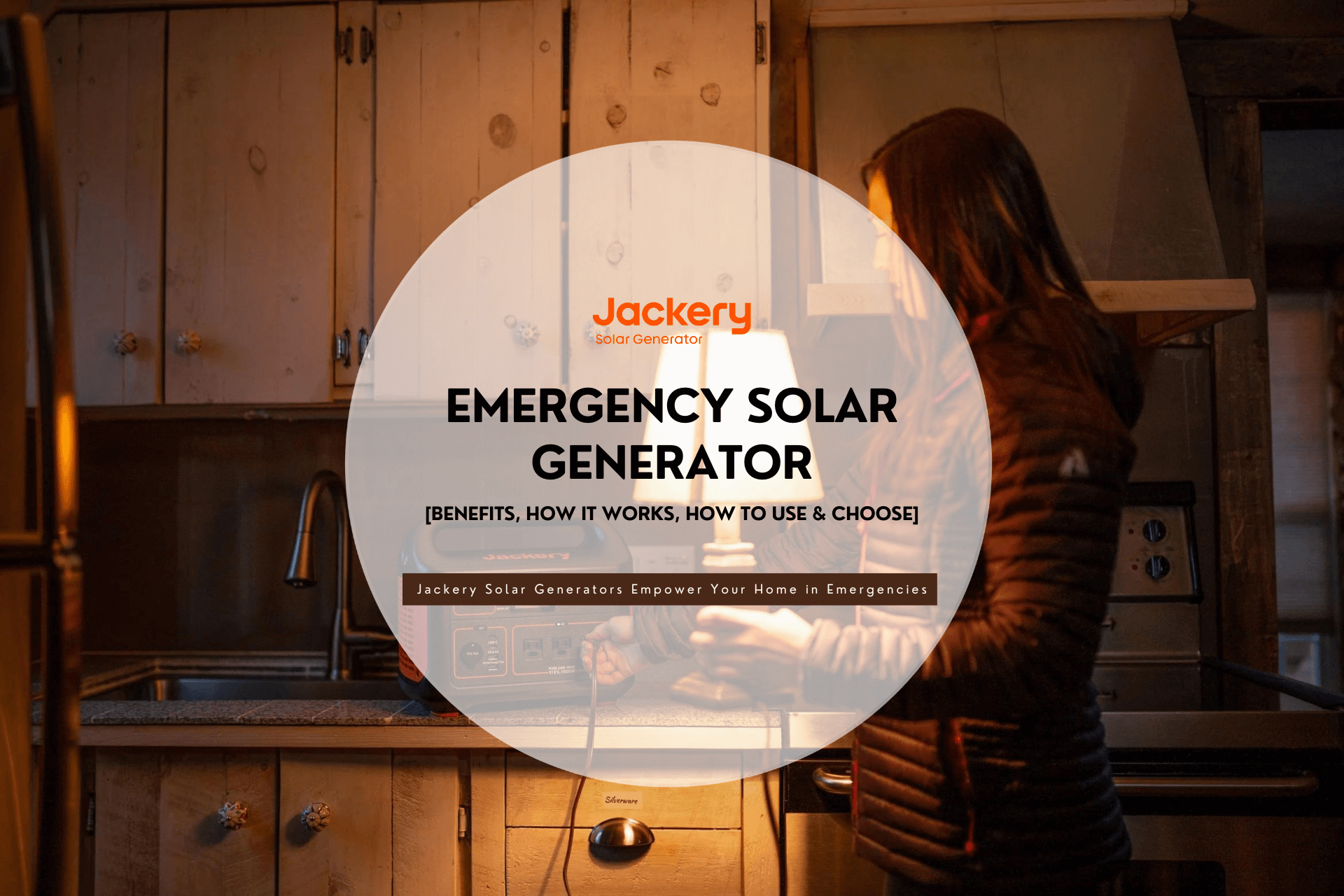
That's why we've assembled the three best emergency solar generators on the market, ideal for being adequately prepared for home power outages and emergencies. You will learn more about emergency solar generators, including how they work, why they are necessary, and how to use and select one. We highly recommend Jackery Solar Generators as the best home emergency solar generators with sufficient capacity to power essential appliances.
|
Products |
Images |
Capacity |
Rated / Peak Power |
Battery |
Size |
|
Solar Generator 2000 Plus |
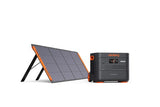 |
2-12 kWh |
3000W Rated, 6000W Peak |
LiFePO4 |
14.7x18.6x14.1in |
|
Solar Generator 1000 Plus |
 |
1.25-5 kWh |
2000W Rated, 4000W Peak |
LiFePO4 |
14x10.24x11.14in |
Why You Need An Emergency Solar Generator?
Are you concerned about being left literally and figuratively in the dark the next time the grid goes down? What is your contingency plan if the power goes out? In these unprecedented times, power disruptions are increasing in frequency daily.
In addition, when the power goes out, existence comes to a grinding halt. Food is immediately at risk of spoiling, electronic devices cannot be charged, and appliances and medical equipment become ineffective. You are in dire straits. Protect yourself from this risk with a solar generator for emergencies.
Emergency Home Power: One of the primary reasons to consider a solar-powered generator is if you live in an area that experiences frequent blackouts or severe weather and are looking for a backup power system for your residence. Until recently, generators powered by fossil fuels were the most popular option, but many now recognize the numerous advantages of solar power generators.
Peace of Mind: During an outage, preparing to power your home with solar generators provides you and your family peace of mind. During a storm or power disruption, you can power your air conditioner, refrigerator, and other essentials with the appropriate-size solar generator
Sustainability: Solar energy is the most abundant and pure renewable resource currently available. No matter why you use a solar generator, you will reduce your carbon footprint and aid in the fight against climate change.
Better for Indoor Use: A gas-guzzling generator needs a steady supply of fossil fuel and somewhere to be stored. The storage of gasoline liters could be more practical and potentially hazardous. Gas generators produce carbon monoxide emissions; therefore, they must be kept outside and safe from the home. Fossil-fuel-powered generators cannot be left out in the downpour, so they must be covered and ventilated.
Emergency solar generators do not utilize fossil fuels and are entirely clean and odorless, making them safe and convenient for use anywhere, including inside your home. For instance, Jackery Solar Generators are silent, making them ideal for use indoors or on outdoor excursions.
Save Electricity Bills: Whole-house solar generators can be pricey, so it's no surprise that people ask if they're worth it. However, a significant reason to switch to solar generators for residential use is to utilize renewable energy and save money over time.
How Does An Emergency Solar Generator Work?
An emergency solar generator resembles a battery in a canister. It is referred to as a generator or power station because it functions identically to a fuel generator; instead of pouring fuel into it, you put in a few solar panels, which will recharge or maintain the charge on your solar generator.
In addition, you can connect your appliances, electronics, and other devices directly to its front, as it is equipped with standard outlets and USB ports. Therefore, you can pour solar power into the generator via the panels while using that power to endure and thrive at any time.
A solar generator has a battery, charge controller, and power inverter in a box to keep things basic. So that the battery does not overheat, the charge controller regulates the quantity of power coming in from the solar panels.
The battery stores the energy we generate from the solar, and the power inverter is then connected between the battery and the outlets, enabling us to use the energy we generate and store it in the batteries. Combining solar panels and portable power stations, Jackery Solar Generators maximize the use of solar energy.
How Does A Jackery Solar Generator Work?
Jackery is the leading manufacturer of portable power stations, solar panels, and portable solar generators. To safeguard the environment, we constantly consider sustainability and utilize solar energy as our power source.
Jackery Solar Generators, as the best emergency solar generators, combine Jackery Solar Panels and Portable Power Stations to convert sunlight into electricity, which can then be used to power domestic appliances, such as refrigerators, water pumps, CPAP machines, and more, during a power outage or an emergency.

The monocrystalline silicon solar cells allow for more excellent absorption of sunlight and a higher conversion efficiency. Pure sine wave inverter and MPPT (Maximum Power Point Tracking) charge controller are contained within the Jackery Portable power station to ensure a constant and seamless flow of electricity.
Therefore, when using solar cables or connectors to connect them, solar energy can be utilized to its fullest extent, whether indoors or outdoors. In addition, Explorer Portable Power Stations feature a pass-through function that allows for simultaneous charging of the power station and household appliances.
How to Use An Emergency Solar Generator?
Unexpected power outages can occur without warning. Natural disasters such as tornadoes, inundations, hurricanes, ice storms, and lightning can destroy a community's power. Your refrigerator may be ruined when a power outage lasts hours or even days.
In the winter, a power interruption can render your home's heating system inoperable. However, it would be best to maintain comfort in your residence. A solar emergency generator can prevent power outage problems.
Power Essential Appliances
During a crisis, you must have access to electricity for appliances such as your refrigerator, electric stove, and medical equipment. Solar emergency generators can keep these devices operational until power is restored.
Use generators powered by fuel only outside and away from windows. Jackery Solar Generators emit no emissions, operate in near silence, and can be utilized indoors.
Charge Personal Devices
Maintaining contact with the outside world is essential during times of crisis. Portable solar generators can charge electronic devices such as cell phones, laptops, and tablets, allowing you to communicate with others and seek aid.
Keep Lighting
Emergency solar generators can power LED lights, delivering much-needed light when the power goes out, which is especially crucial during natural disasters and other situations at night. Each Jackery Portable Power Station has a brilliant LED light with an SOS mode.
This built-in illumination is helpful during a blackout. The SOS mode flashes in the conventional pattern of three short, three long, and three short pulses to alert others of your distress. It's a great thing to have on hand in an emergency.
A Jackery Solar Generator also permits rechargeable flashlights, eliminating the need for additional batteries. Keep in mind that smartphones also contain lighting. With a Jackery Portable Power Stations, you can bring illumination wherever you go by plugging in light bulbs, lanterns, and other light sources.
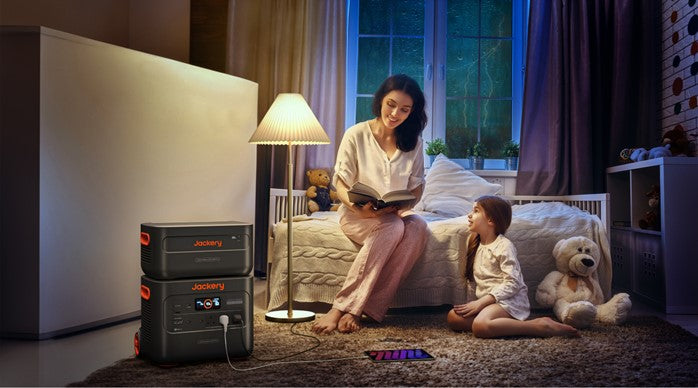
Portable solar generators can power medical equipment such as CPAP machines, oxygen concentrators, and nebulizers during medical emergencies. Thus, emergency solar generators can be lifesavers, mainly if a medical emergency occurs during a blackout or in a remote area without access to the power infrastructure.
Emergency Preparedness
During natural disasters and accidents, search and rescue operations require electricity to fuel their equipment. Portable solar generators can provide them with the necessary electrical power to operate. A portable solar generator is an essential part of any emergency kit. It can charge your communication devices and an emergency radio in preparation for an emergency.
How Many Watts Does It Take to Run A Home?
On average, it takes 1,214 watts to power a residence in the United States. The ordinary American home consumes an average of 10,632 kilowatt-hours (kWh) of electricity annually. That is 29,130 watts (W) per day, which, when divided by 24 hours, yields an average daily power consumption of 1,214 W for a residence. (Data Source: Energy Information Administration)
Depending on the time of day and where you live, your home's wattage needs may vary widely, from several thousand to a few hundred watts.
The electricity it takes to operate your home depends on what appliances you run, how efficient they are, and the size of your home. EV outlets, central air conditioners, ovens, and clothes dryers are the appliances that use the most electricity.
Heating and ventilation systems typically impact your electricity consumption, whereas appliances that do not require constant operation consume less power. Here are the wattages that various devices in various areas of the residence may consume:
|
Appliances |
Running Watts |
Starting Watts |
|
Kitchen |
||
|
Microwave |
1000W |
0 |
|
Refrigerator |
300W |
1000W |
|
Oven |
1500W |
0 |
|
Living Room |
||
|
TV |
200W |
0 |
|
Light Bulb |
50W |
0 |
|
Heating & Cooling |
||
|
Space Heater |
1500W |
3000W |
|
Heat Pump |
550-1500W |
1000W |
|
Window AC |
500W |
1000W |
|
Central AC |
2500W |
2500W |
|
Laundry |
||
|
Washing Machine |
1150W |
2250W |
|
Dryer |
1500-5000W |
3000-6500W |
|
Miscellaneous |
||
|
Computer |
30-200W |
0 |
|
Phone Charger |
5W |
0 |
|
Printer |
400-600W |
0 |
Jackery Solar Generators for Emergencies
An emergency solar generator may be the best option for generating pure and dependable electricity during power outages. These generators can power various electronics and appliances, and their portability and light weight make them easy to transport.
Jackery provides solutions to power and back up your home during a power disruption. Alternatively, you can attain energy independence by going utterly off-grid with solar panels and Jackery Solar Generators.
Jackery Solar Generators are user-friendly, portable, and compact. Choose between 240Wh and 12kWh based on the energy needs of your household.
Before purchasing a solar generator, it is prudent to ascertain the quantity of emergency electricity needed. This formula can calculate the operational lifespan of the Jackery Solar Generator.
Working Time = Power Station Capacity*0.85 / Your Device's Operating Wattage
Using the Jackery Solar Generator 2000 Pro (2160Wh), a 300W refrigerator can be powered for approximately six hours, sufficient for emergency use at home (2160*0.85/300). In addition, the extensible battery module included with Solar Generator 2000 Plus can provide up to 12 kWh of additional power if required. Using the above formula, it is straightforward to determine which solar generator to purchase.
Jackery Solar Generator 2000 Plus
The Solar Generator 2000 Plus has an adjustable capacity between 2 and 12 kWh. With the addition of a battery cell and solar panels, a massive 12 kWh capacity is possible. It is suitable for emergency backup at home. An extraordinary two hours are required for a complete solar charge; power has become entirely autonomous, charging via solar energy, and charging time has reached an incredible two hours.
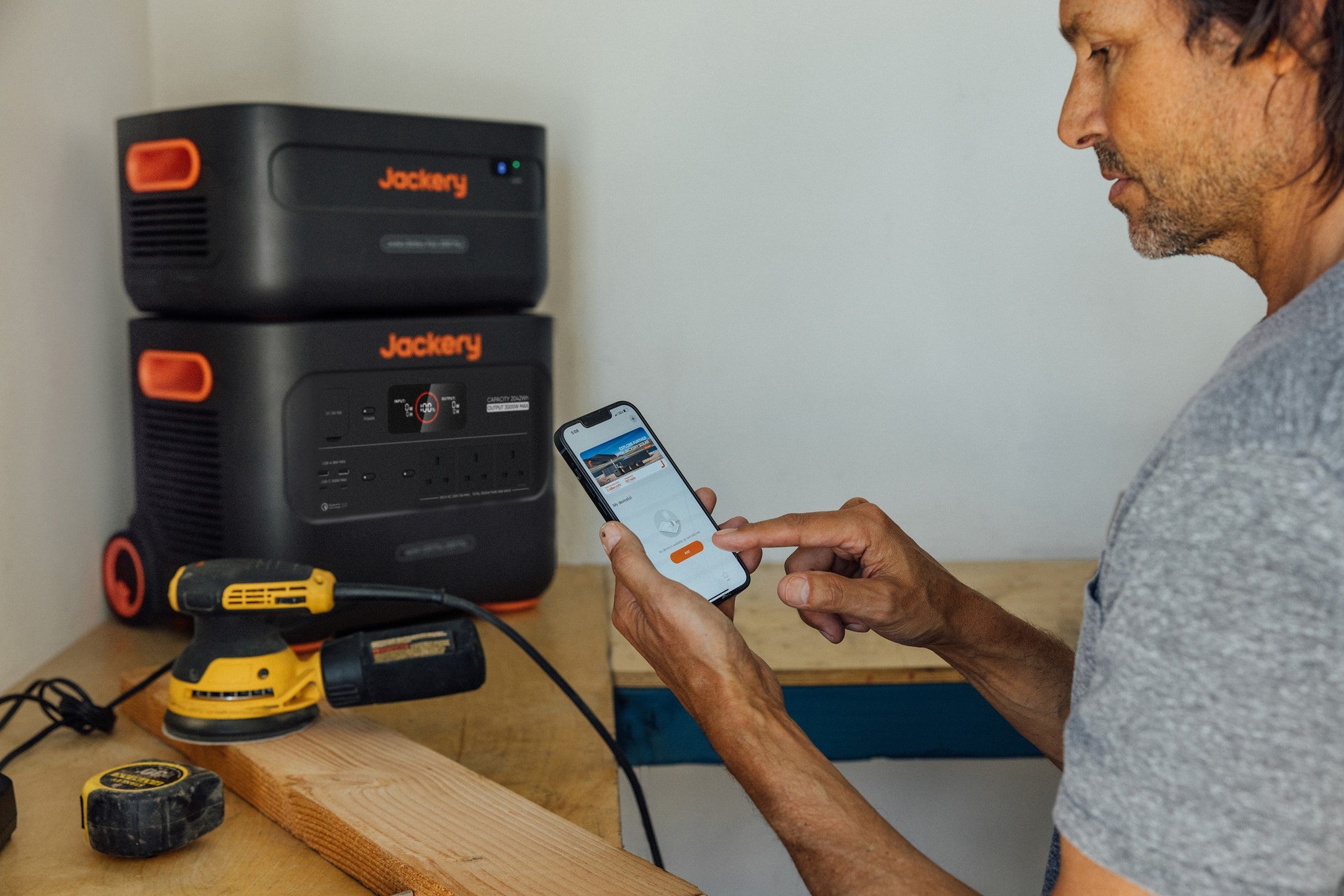
With its 2 kWh capacity and up to 12 kWh of extended power, the Explorer 2000 Plus portable power station takes solar charging to the next level. A single Jackery Explorer 2000 Plus power station can accommodate up to five add-on battery packs simultaneously, increasing its capacity from 2 kWh to an impressive 12 kWh and making it ideal for short-term power outages.
Connecting two Jackery Explorer 2000 Plus power stations increases capacity to a staggering 12 kWh, sufficient to power a residence for an extended time.
The standby mode of the 2000 Plus is so long that it can retain a 50% charge for up to two years! Relax after connecting your appliances to our 2000 Plus! With a 20ms EPS, your refrigerator, oven, lighting system, and washing machine will continue to function within a flicker of an eye.
|
Product |
Jackery Solar Generator 2000 Plus |
|
Capacity |
2042.8Wh |
|
Battery |
LFP (LiFePO4 battery) |
|
Life Cycles |
4000 cycles to 70%+ capacity |
|
Dimensions |
14.7x18.6x14.1in |
|
Using Temperature |
Charge Temperature:0~45°C (32~113 °F) Discharge Temperature:-10~45°C (14~113°F) |
|
Output Ports |
5*AC Output: 120V~ 60Hz, 20A Max, 120V~ 60Hz, 25A Max, 3000W Max, 6000W surge; 2*USB-A: Quick Charge 3.0, 18W Max; 2*USB-C: 100W Max, (5V, 12V, 9V, 15V, 20V up to 5A); 1*Carport: 12V⎓10A |
|
Working Hours |
Refrigerator(300W): 5.4H Oven(1500W): 1.1H Microwave(1000W): 1.6H TV(200W): 8.2H Light Bulb(50W): 32.7H Space Heater(1500W): 1.1H |
Jackery Solar Generator 1000 Plus
The Jackery Solar Generator 1000 Plus is the best option for comparable portable power stations due to its unparalleled output. It provides support for household emergencies in a variety of situations. It is expandable to 5 power levels and offers the household three days of emergency backup power. Versatile and expandable in capacity, this solar generator is an all-in-one solution for powering your resistance.
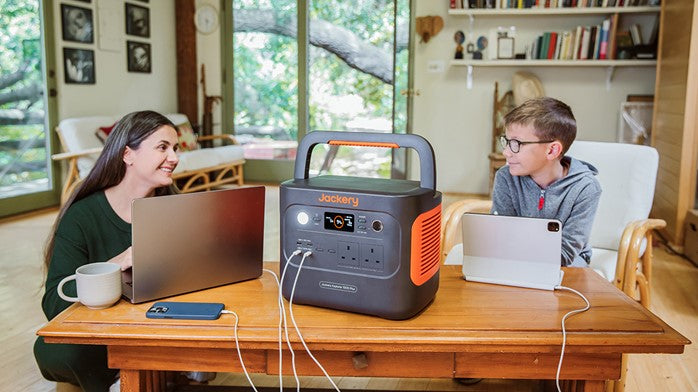
With a capacity of 1264Wh and an output of 2000W, the Explorer 1000 Plus has the highest production among products of a comparable level, supporting 99.9% of devices. With capacity ranging from 1.25 kWh to 5 kWh, it is simple to maintain connectivity and power essential devices, ensuring safety and convenience in emergencies. For instance, it can power a 50W light bulb for 20.2 hours.
The Jackery 1000 Plus's Lithium Iron Phosphate (LiFePO4) battery provides a constant voltage and pure sine wave, ensuring the safety of all your electrical appliances over its 10-year lifecycle. Utilize Advanced IBC Technology's cutting-edge power to provide an astoundingly rapid solar charge in 2 hours.
|
Product |
Jackery Solar Generator 2000 Plus |
|
Capacity |
1264.64Wh |
|
Battery |
LFP (LiFePO4 battery) |
|
Life Cycles |
4000 cycles to 70%+ capacity |
|
Dimensions |
14x10.24x11.14in |
|
Using Temperature |
14-113F (-10~45℃) |
|
Output Ports |
3*AC Output: 120V~60Hz, 2000W (4000W Peak); 2*USB-A: 18W Max, 5-5V⎓3A; 2*USB-C: 100W Max, (5V, 9V, 12V, 15V, 20V up to 5A); 1*Carport: 12V⎓10A |
|
Working Hours |
Refrigerator(300W): 3.4H Oven(1500W): 0.7H Microwave(1000W): 1H TV(200W): 5.1H Light Bulb(50W): 20.2H Space Heater(1500W): 0.7H |
What Mistakes to Avoid to Use Emergency Solar Generators?
Emergency solar generators are advantageous in emergencies but can be dangerous if not used properly. Here are a few common errors to avoid when utilizing portable solar generators during emergencies:
Overloading: By connecting too many devices to the generator, you risk damaging the battery and diminishing its life. It is imperative to meticulously read the manufacturer's instructions and adhere to the load recommendations.
Incompatible Devices: Solar generators are occasionally incompatible with specific electronic devices. Before using the generator, verify the power requirements of your devices. Using incompatible devices can cause injury to the generator's battery and decrease its lifespan.
No Cleaning: Dust and debris on the solar panels can reduce efficiency and interfere with the generator's operation. Solar panels must be thoroughly cleaned regularly for optimal performance.
How to Choose The Emergency Solar Generator?
When purchasing an emergency solar generator, there are several factors to consider, with the following being among the most crucial:
Power Output: Watts is the standard measurement unit for a portable solar generator's output power (W). Select a generator capable of powering all of your essential devices and appliances. Ensure the generator you buy can handle the combined wattage of your equipment.
Battery Capacity: Watt-hours are used to quantify the battery power of a portable solar generator (Wh). As previously stated, the duration of a solar generator's ability to supply electricity is primarily dependent on its battery capacity.
Ensure that your selected generator has sufficient battery power to suit your needs. Jackery Solar Generators, for example, are constructed with lithium-ion and LiFePO4 batteries with increased capacities to generate more electricity and extend their service lives.
Charging Time: The charging time of a portable solar generator is the time required to completely charge the battery via solar panels or an AC power outlet. How long it takes to charge depends on the generator's efficiency and how much sunlight it receives. Choose a generator with a short charging period if you need to use it immediately in an emergency.
Portability: A lightweight and portable solar generator is always practical, but these characteristics are essential in emergencies. Therefore, it is vital to search for a generator that is portable and light.


























































































